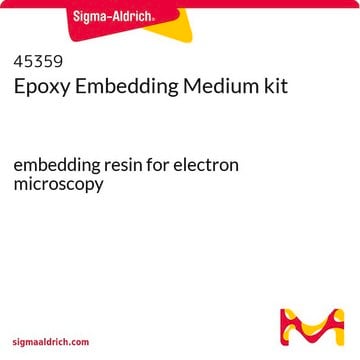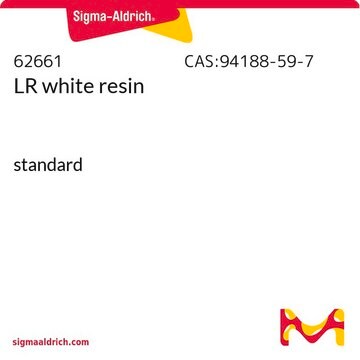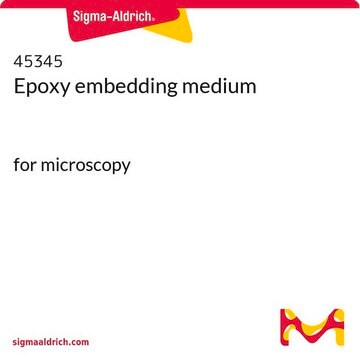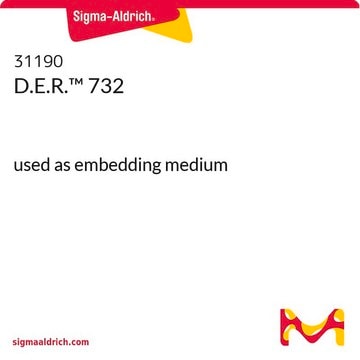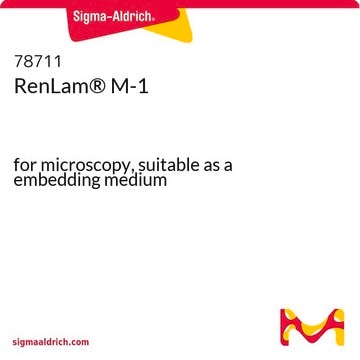EM0300
Spurr Low Viscosity Embedding Kit
hydrophobic resin for embedding histological samples
Synonym(s):
resin for specimen preparation
Sign Into View Organizational & Contract Pricing
All Photos(1)
About This Item
UNSPSC Code:
12171500
NACRES:
NA.47
Recommended Products
application(s)
hematology
histology
storage temp.
room temp
General description
Spurr resin is a hydrophobic resin. It is less viscous than epon mixtures and is easier to dispense. The low viscosity of the resin contributes to its penetration in tissue, mineral and dense structures. A low viscosity of 60 cps also allows easy penetration into a variety of difficult materials.
Application
Exceptional penetration for tissue, mineral, and dense structures. A low viscosity of 60 cps allows easy penetration into a variety of difficult materials. Spurr low viscosity embedding kit has been used to embed histological samples like tissues, organs and embryos. It may be used to prepare mineral specimens for polishing. The low viscosity of the Spurr formulation allows rapid infiltration into tissues, minerals, and other dense structures.
Kit Components Only
Product No.
Description
- Nonenylsuccinic anhydride 450 g
- D.E.R. 736 250 g
- Dimethylaminoethanol 100 g
- ERL 4221 250 g
Signal Word
Danger
Hazard Statements
Precautionary Statements
Hazard Classifications
Acute Tox. 3 Inhalation - Acute Tox. 4 Dermal - Acute Tox. 4 Oral - Eye Dam. 1 - Flam. Liq. 3 - Muta. 2 - Skin Corr. 1B - STOT SE 3
Target Organs
Respiratory system
Storage Class Code
3 - Flammable liquids
Flash Point(F)
102.2 °F
Flash Point(C)
39 °C
Certificates of Analysis (COA)
Search for Certificates of Analysis (COA) by entering the products Lot/Batch Number. Lot and Batch Numbers can be found on a product’s label following the words ‘Lot’ or ‘Batch’.
Already Own This Product?
Find documentation for the products that you have recently purchased in the Document Library.
Customers Also Viewed
Samir Dekali et al.
Toxicology, 365, 1-8 (2016-08-01)
DWCNTs have numerous industrial and biomedical applications and several studies reported that they could act as immunomodulator systems. The immune system is the first line of defence of the human body when exposed to particulate matter. In order to investigate
Gergely Hegyi et al.
The Journal of experimental biology, 221(Pt 9) (2018-04-05)
Structural plumage colour is one of the most enigmatic sexually selected traits. The information content of structural colour variation is debated, and the heterogeneity of the findings is hard to explain because the proximate background of within-species colour differences is
Sara Abolhassani Rad et al.
Plant signaling & behavior, 13(10), e1517075-e1517075 (2018-09-27)
AROGENATE DEHAYDRATASE2 (ADT2) is a member of the Arabidopsis thaliana ADT family. All members of this family act as arogenate dehydratases in phenylalanine biosynthesis, decarboxylating/dehydrating arogenate to phenylalanine. ADT2 is detected in stromules, and as a ring around the equatorial
Frederick J Warren et al.
The Plant journal : for cell and molecular biology, 84(3), 634-646 (2015-09-25)
Infrared microspectroscopy is a tool with potential for studies of the microstructure, chemical composition and functionality of plants at a subcellular level. Here we present the use of high-resolution bench top-based infrared microspectroscopy to investigate the microstructure of Triticum aestivum L.
Gregor Belušič et al.
The Journal of experimental biology, 220(Pt 11), 2047-2056 (2017-03-28)
The visual system of the European corn borer (
Our team of scientists has experience in all areas of research including Life Science, Material Science, Chemical Synthesis, Chromatography, Analytical and many others.
Contact Technical Service